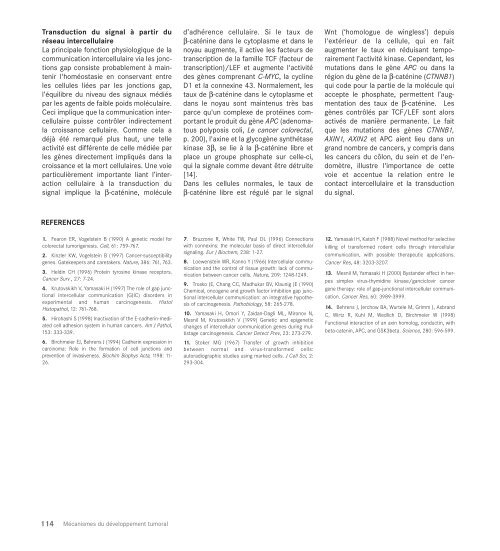3 - IARC
3 - IARC
3 - IARC
Create successful ePaper yourself
Turn your PDF publications into a flip-book with our unique Google optimized e-Paper software.
Transduction du signal à partir du<br />
réseau intercellulaire<br />
La principale fonction physiologique de la<br />
communication intercellulaire via les jonctions<br />
gap consiste probablement à maintenir<br />
l'homéostasie en conservant entre<br />
les cellules liées par les jonctions gap,<br />
l’équilibre du niveau des signaux médiés<br />
par les agents de faible poids moléculaire.<br />
Ceci implique que la communication intercellulaire<br />
puisse contrôler indirectement<br />
la croissance cellulaire. Comme cela a<br />
déjà été remarqué plus haut, une telle<br />
activité est différente de celle médiée par<br />
les gènes directement impliqués dans la<br />
croissance et la mort cellulaires. Une voie<br />
particulièrement importante liant l’interaction<br />
cellulaire à la transduction du<br />
signal implique la β-caténine, molécule<br />
d’adhérence cellulaire. Si le taux de<br />
β-caténine dans le cytoplasme et dans le<br />
noyau augmente, il active les facteurs de<br />
transcription de la famille TCF (facteur de<br />
transcription)/LEF et augmente l'activité<br />
des gènes comprenant C-MYC, la cycline<br />
D1 et la connexine 43. Normalement, les<br />
taux de β-caténine dans le cytoplasme et<br />
dans le noyau sont maintenus très bas<br />
parce qu'un complexe de protéines comportant<br />
le produit du gène APC (adenomatous<br />
polyposis coli, Le cancer colorectal,<br />
p. 200), l'axine et la glycogène synthétase<br />
kinase 3β, se lie à la β-caténine libre et<br />
place un groupe phosphate sur celle-ci,<br />
qui la signale comme devant être détruite<br />
[14].<br />
Dans les cellules normales, le taux de<br />
β-caténine libre est régulé par le signal<br />
Wnt (‘homologue de wingless’) depuis<br />
l'extérieur de la cellule, qui en fait<br />
augmenter le taux en réduisant temporairement<br />
l’activité kinase. Cependant, les<br />
mutations dans le gène APC ou dans la<br />
région du gène de la β-caténine (CTNNB1)<br />
qui code pour la partie de la molécule qui<br />
accepte le phosphate, permettent l’augmentation<br />
des taux de β-caténine. Les<br />
gènes contrôlés par TCF/LEF sont alors<br />
activés de manière permanente. Le fait<br />
que les mutations des gènes CTNNB1,<br />
AXIN1, AXIN2 et APC aient lieu dans un<br />
grand nombre de cancers, y compris dans<br />
les cancers du côlon, du sein et de l'endomètre,<br />
illustre l'importance de cette<br />
voie et accentue la relation entre le<br />
contact intercellulaire et la transduction<br />
du signal.<br />
REFERENCES<br />
1. Fearon ER, Vogelstein B (1990) A genetic model for<br />
colorectal tumorigenesis. Cell, 61: 759-767.<br />
2. Kinzler KW, Vogelstein B (1997) Cancer-susceptibility<br />
genes. Gatekeepers and caretakers. Nature, 386: 761, 763.<br />
3. Heldin CH (1996) Protein tyrosine kinase receptors.<br />
Cancer Surv , 27: 7-24.<br />
4. Krutovskikh V, Yamasaki H (1997) The role of gap junctional<br />
intercellular communication (GJIC) disorders in<br />
experimental and human carcinogenesis. Histol<br />
Histopathol, 12: 761-768.<br />
5. Hirohashi S (1998) Inactivation of the E-cadherin-mediated<br />
cell adhesion system in human cancers. Am J Pathol,<br />
153: 333-339.<br />
6. Birchmeier EJ, Behrens J (1994) Cadherin expression in<br />
carcinoma: Role in the formation of cell junctions and<br />
prevention of invasiveness. Biochim Biophys Acta, 1198: 11-<br />
26.<br />
7. Bruzzone R, White TW, Paul DL (1996) Connections<br />
with connexins: the molecular basis of direct intercellular<br />
signaling. Eur J Biochem, 238: 1-27.<br />
8. Loewenstein WR, Kanno Y (1966) Intercellular communication<br />
and the control of tissue growth: lack of communication<br />
between cancer cells. Nature, 209: 1248-1249.<br />
9. Trosko JE, Chang CC, Madhukar BV, Klaunig JE (1990)<br />
Chemical, oncogene and growth factor inhibition gap junctional<br />
intercellular communication: an integrative hypothesis<br />
of carcinogenesis. Pathobiology, 58: 265-278.<br />
10. Yamasaki H, Omori Y, Zaidan-Dagli ML, Mironov N,<br />
Mesnil M, Krutovskikh V (1999) Genetic and epigenetic<br />
changes of intercellular communication genes during multistage<br />
carcinogenesis. Cancer Detect Prev, 23: 273-279.<br />
11. Stoker MG (1967) Transfer of growth inhibition<br />
between normal and virus-transformed cells:<br />
autoradiographic studies using marked cells. J Cell Sci, 2:<br />
293-304.<br />
12. Yamasaki H, Katoh F (1988) Novel method for selective<br />
killing of transformed rodent cells through intercellular<br />
communication, with possible therapeutic applications.<br />
Cancer Res, 48: 3203-3207.<br />
13. Mesnil M, Yamasaki H (2000) Bystander effect in herpes<br />
simplex virus-thymidine kinase/ganciclovir cancer<br />
gene therapy: role of gap-junctional intercellular communication.<br />
Cancer Res, 60: 3989-3999.<br />
14. Behrens J, Jerchow BA, Wurtele M, Grimm J, Asbrand<br />
C, Wirtz R, Kuhl M, Wedlich D, Birchmeier W (1998)<br />
Functional interaction of an axin homolog, conductin, with<br />
beta-catenin, APC, and GSK3beta. Science, 280: 596-599.<br />
114 Mécanismes du développement tumoral

















